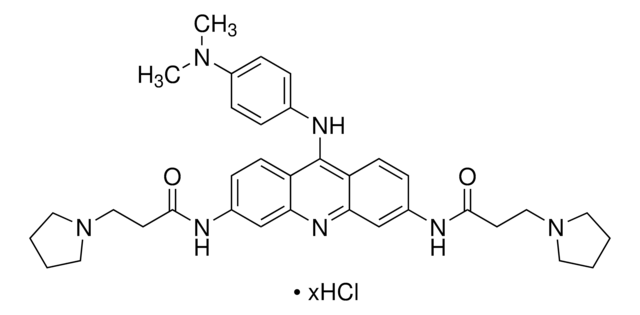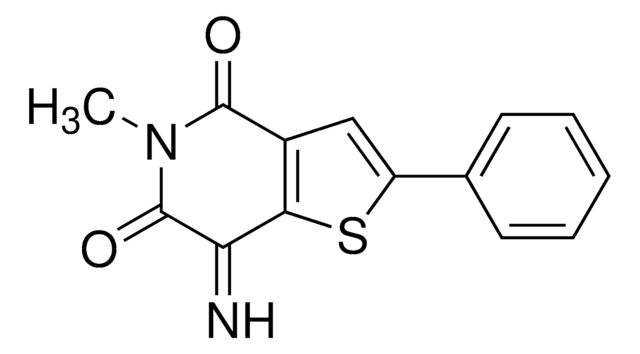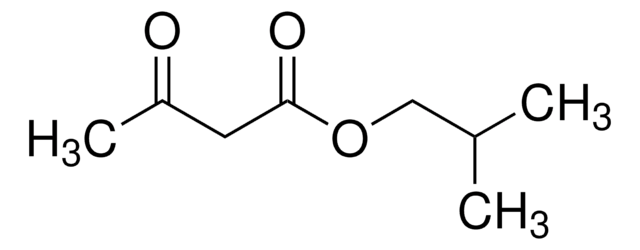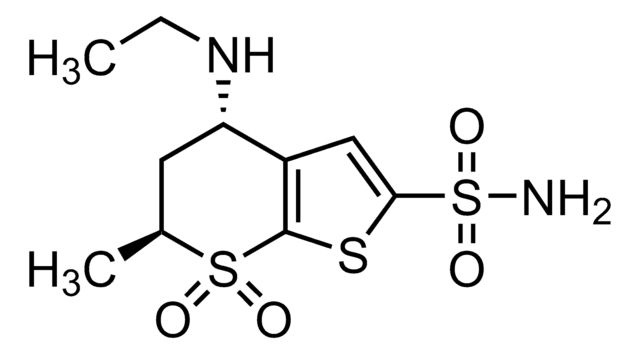P0108
PRL-3 Inhibitor I
≥98% (HPLC), solid
Sinónimos:
5-[[5-bromo-2-[(2-bromophenyl)methoxy]phenyl]methylene]-2-thioxo-4-thiazolidinone, Phosphatase of regenerating liver-3, Inhibitor I
About This Item
Productos recomendados
Nivel de calidad
Ensayo
≥98% (HPLC)
Formulario
solid
condiciones de almacenamiento
protect from light
color
yellow
solubilidad
DMSO: >10 mg/mL
H2O: <2 mg/mL
temp. de almacenamiento
−20°C
cadena SMILES
Brc1ccc(OCc2ccccc2Br)c(c1)\C=C3\SC(=S)NC3=O
InChI
1S/C17H11Br2NO2S2/c18-12-5-6-14(22-9-10-3-1-2-4-13(10)19)11(7-12)8-15-16(21)20-17(23)24-15/h1-8H,9H2,(H,20,21,23)/b15-8+
Clave InChI
HXNBAOLVPAWYLT-OVCLIPMQSA-N
Aplicación
- to test its effect on classical Hodgkin lymphoma cell survival
- in the human umbilical vein endothelial cells tube formation assay
- to test its effect on the migration of neural crest cells
Acciones bioquímicas o fisiológicas
Características y beneficios
Código de clase de almacenamiento
11 - Combustible Solids
Clase de riesgo para el agua (WGK)
WGK 3
Equipo de protección personal
dust mask type N95 (US), Eyeshields, Gloves
Elija entre una de las versiones más recientes:
Certificados de análisis (COA)
¿No ve la versión correcta?
Si necesita una versión concreta, puede buscar un certificado específico por el número de lote.
¿Ya tiene este producto?
Encuentre la documentación para los productos que ha comprado recientemente en la Biblioteca de documentos.
Artículos
Protein tyrosine phosphatases (PTPs) and related enzymes (more than a hundred coded by the human genome) are more numerous than serine/threonine phosphatases. They belong to four families, three of which possess a conserved cysteine for catalysis and some conserved features of 3-dimensional structure. The catalytic mechanism of these PTPs involves the transient formation of a covalently phosphorylated enzyme.
Nuestro equipo de científicos tiene experiencia en todas las áreas de investigación: Ciencias de la vida, Ciencia de los materiales, Síntesis química, Cromatografía, Analítica y muchas otras.
Póngase en contacto con el Servicio técnico








